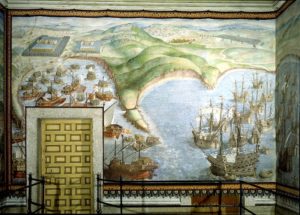It was in Terceira, Angra, that the first city of the Azores and the seat of the Azorean Diocese were established, with the creation of the Bishopric of Angra and the Island of the Azores, in 1534. It was decided that the construction of a new , in 1570, began the construction of the Sé Catedral de Angra. The Sé’s works were interrupted during the crisis of succession of 1580.
After a period of 3 years, in 1583, the Spaniards managed to invade Terceira, through the landing of the Bay of Mós. There followed a time when the population was punished for their support to the Portuguese suitor. In the midst of this, the works of the Church of the See continued. In the seventeenth century when the works were completed, the Church of the Cathedral had a rectangular plan in Renaissance style and “floor”. With materials coming from all parts of the world, during the XVII and XVIII centuries, both by order of kings and court and by offerings, the Cathedral of Angra was embellished with the baroque and grandeur of the Indies and the Americas . The Cathedral of Angra became a symbol of the wealth of the Portuguese Empire.
In century XVII was born a legend linked to the Cathedral, the one of the “Boy of the Choir and the Sineira of the Cathedral”. According to this, in the treasure of the Church of the Cathedral existed an exotic image of Saint Anthony of Lisbon, in which this one was dressed like a boy of the choir, something never seen. Legend has it that one day a chapel master who was very concerned about achieving musical harmony among his students threatened to hit one of them if he did not start singing the songs in the right way. The frightened boy fled, heading for one of the towers of the Cathedral. He climbed the steep spiral staircase that led to the bells and to the pinnacles of the towers of the Cathedral angrense, and when he reached the top, confusing the noise of the wind with the noise of footsteps , thought he heard the master of the chapel and threw himself from the top of the tower where he was. The child was saved by a divine wind that sustained it in the air, flying through three streets until it was deposited on the roof of the Convent of Our Lady of Hope. To commemorate this divine action, the father of the child ordered to make the aforementioned image of Saint Anthony dressed as a choirboy, who for many years was exposed in the Cathedral. The boy would become a priest.
The Earthquake of January 1, 1980, the highest intensity of the last 200 years in Portugal, with a magnitude of 7.2 on the Richter scale, with an epicenter 35 km southwest of Angra do Heroísmo, the most affected city, strongly damaged the Church of the Cathedral. A few days later, it began to rise again, following the philosophy of putting it as it was, maintaining the interior. The Sé suffered a collapse, in 1983, that destroyed one of the columns and the frontispiece. When repairs were taking place, the Sé Catedral de Angra do Heroísmo was the victim of a fire, on September 25, 1983, recently passed 30 years.
The fire was fired by a young man who had access to the interior of the Cathedral and was later declared a psychiatric patient, but at the time some people suspected that the action had been committed. Some people still say he was “crazy.” According to the population, the scene was “scary” because the fire was “so high that it crossed the street and threatened to spread out several blocks from Angra do Heroísmo.” Fear settles, it seemed that “the whole city center fire. “Fortunately the fire was controlled.
The damage from the fire was incalculable, the furniture burned all over, the chairs of the canons, the high choir and the lower choir, the pipe organs, the wooden chandeliers, and the floor were lost. The beauty of the Baroque vanished, with the destruction of the coffered ceilings, the images carved on the wall, the frames and the gilt carved frames that burned. Only what was movable, such as silverware, facings, and screens, which had been moved to the seminary hall, was saved.
The Cathedral Church rose again from the ashes and was reborn, retaining its grandeur and grandeur. Thus, on November 3, 1985, the Igreja da Sé was reopened to worship and dedicated the new altar by the then Patriarch of Lisbon D. Antonio Ribeiro. It remains the seat of the bishopric of Angra and Azores, the largest temple in the Azores. It is necessary to bet on the recovery of several pieces that have delayed its restoration, it is necessary to value our treasures.
Text and Photo / Francisco Miguel Nogueira | franciscomgl@gmail.com
Source: Jornal da Praia



